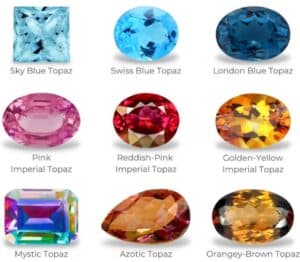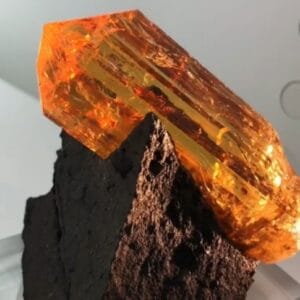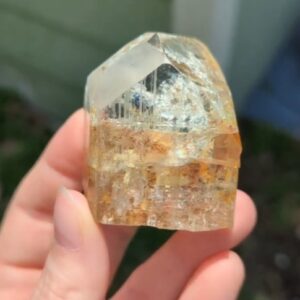Topaz crystals come in different varieties and colors which makes them great for specimen collectors and lapidar artists. Some of the highest-quality specimens can be mined in Colorado, Afghanistan, and Brazil.
Natural Topaz colors include rare and valuable yellows, orange, red, pink, and light blue. The more frequently purchased and affordable Topaz varieties include Blue Topaz and Mystic Topaz. Both of those gemstone receive their beautiful colors from synthetic treatments.
Now that you know most of the Topaz on the market is treated or enhanced then you know that you need to focus on the naturally occurring colors if you’re looking to add high-quality specimens or gem rough to your collection.
Types of Topaz
As many collectors and gem enthusiasts know, Topaz is highly valued and comes in a plethora of incredibly beautiful variations. The stone’s allochromatic qualities mean the colors are derived from impurity elements or crystal structure defects.
Most common types of Topaz include:
- White/Silver
- Smokey
- Australian
- Sherry
- Yellow
- Sky Blue
- Brazillian
- London Blue
- Swiss or Electric Blue

Blue Topaz
Might as well start with the most well-known color of Topaz, Blue Topaz. There are several types, including London Blue Topaz, Swiss Blue, and Sky Blue Topaz. While London blue is a deep, inky blue hue, Swiss blue displays a lighter and almost sky-blue shade.
Natural blue Topaz gemstones are extremely rare and have a tendency to be unstable when exposed to sunlight for extended periods of time. Basically, the Topaz will lose it’s color over time and eventually become a white Topaz.
The enhanced colors will maintain their color because they’ve been treated with small bursts of radiation.

London Blue Topaz
London Blue Topaz is a variety of Topaz that has been treated with radiation. Most of the material starts out an extremely light blue or even clear. The gem dealers will treat the stone with low levels of radiation to change the color but a very appealing dark blue which is known commercially as London Blue Topaz.
You’ll notice jewelers and gem dealers will tell you the stone is naturally occurring which is categorically true but the color is without a doubt enhanced through human activities.
While London Blue Topaz is widely known for its rich blue tone, there are three distinct variations, with London Blue being a medium-dark blue color. Swiss Blue and Light Blue Topaz display much different shades and tones compared to the London Blue Topaz.

Imperial Topaz
Imperial Topaz was named in honor of the Russian Imperial family and is the rarest variety available. Imperials come in lovely, warm pink, peach, and orange hues and are most commonly found in Minas Gerais, Brazil, and the Ural Mountains in Russia.
If you’ve never seen one or held a crystal then you’re missing out. This has to be the best variety of Topaz and should be part of everyone’s collection. In my gemstone-buying career, I’ve only come across a few high-quality parcels of this material and I bought every piece I could afford.
Fun Fact: The Tsarinas of the Russian royal family imposed laws that barred non-royals from wearing or even owning Imperial Topaz, which cemented the stone’s exclusivity.

White Topaz
White Topaz or Glacier Topaz (as it is sometimes known) can be colorless like Diamonds, and the gems are sometimes used as a cheaper alternative for engagement rings. However, since Topaz isn’t as durable as Diamonds, it isn’t necessarily best for daily wear. If you’re looking to add White Topaz to your collection then I would focus on the natural crystals which make for great specimens like the one above.
I’d stay away from alluvial material and faceted stones. They won’t bring top dollar and rarely appreciate in price.

Pink Topaz
Pink Topaz is another impressive variety of Topaz. The faceted stones and crystals are quite unique and high-quality material is limited.
The colors range from pale pink hues to deep and vibrant shades. This is a popular gem choice for jewelry because of the stone’s striking colors and excellent durability.
Pink Topaz is commonly found in Russia, Brazil, and Sri Lanka. However, these stones can also be found in several locations around the globe. The colors of pink Topaz can be natural, but some stones are enhanced using a variety of treatments like heat treatment and irradiation.
Because Topaz is an 8 on the Mohs Hardness Scale, it’s considered hard and durable. Of course, this characteristic makes Topaz an excellent choice for jewelry that is worn frequently.

Yellow Topaz
Again, Topaz, in its natural state, is colorless and often produces a greyish cast. However, the stones can occur as golden browns to yellow hues, which causes them to be confused with Citrine or Yellow Sapphire.
Yellow or Golden Topaz lacks the highly prized red overtones of the Imperial Topaz but the material is more accessible to your everyday collector or gem dealer.

Mystic Topaz
Mystic Topaz seems to be one of the most striking varieties of Topaz available. The stones are coated with a thin layer of titanium, which creates a multicolored iridescent effect but this does not come without sacrifices. The thin layer requires delicate care to maintain its beautiful color. Abrasive cleaning products should always be avoided.
Top 3 Varieties for Gem Collectors
If you made choose the 3 best varieties of Topaz for crystal collectors and gemstone dealers then I’d have to go with the following. Number one would be Imperial Topaz and if you’re wondering why then you’ve never seen a crystal in person. This one is hands down the best Topaz crystal Mother Nature has to offer. Number two would have to be a naturally occurring light blue or yellow Topaz from Colorado or Afghanistan. These crystals can be sourced in decent sizes and are very interesting to look at. They really captivate you. Number 3 would be the pink Topaz. The material hitting the market as of late is very interesting from a specimen point of view and for cutters.
- Identify Enstatite - March 12, 2024
- Identify Cerussite - March 3, 2024
- Identify Bytownite - February 18, 2024

One Response
Topaz is one of my favorites. I learned a lot. Thank you for sharing.